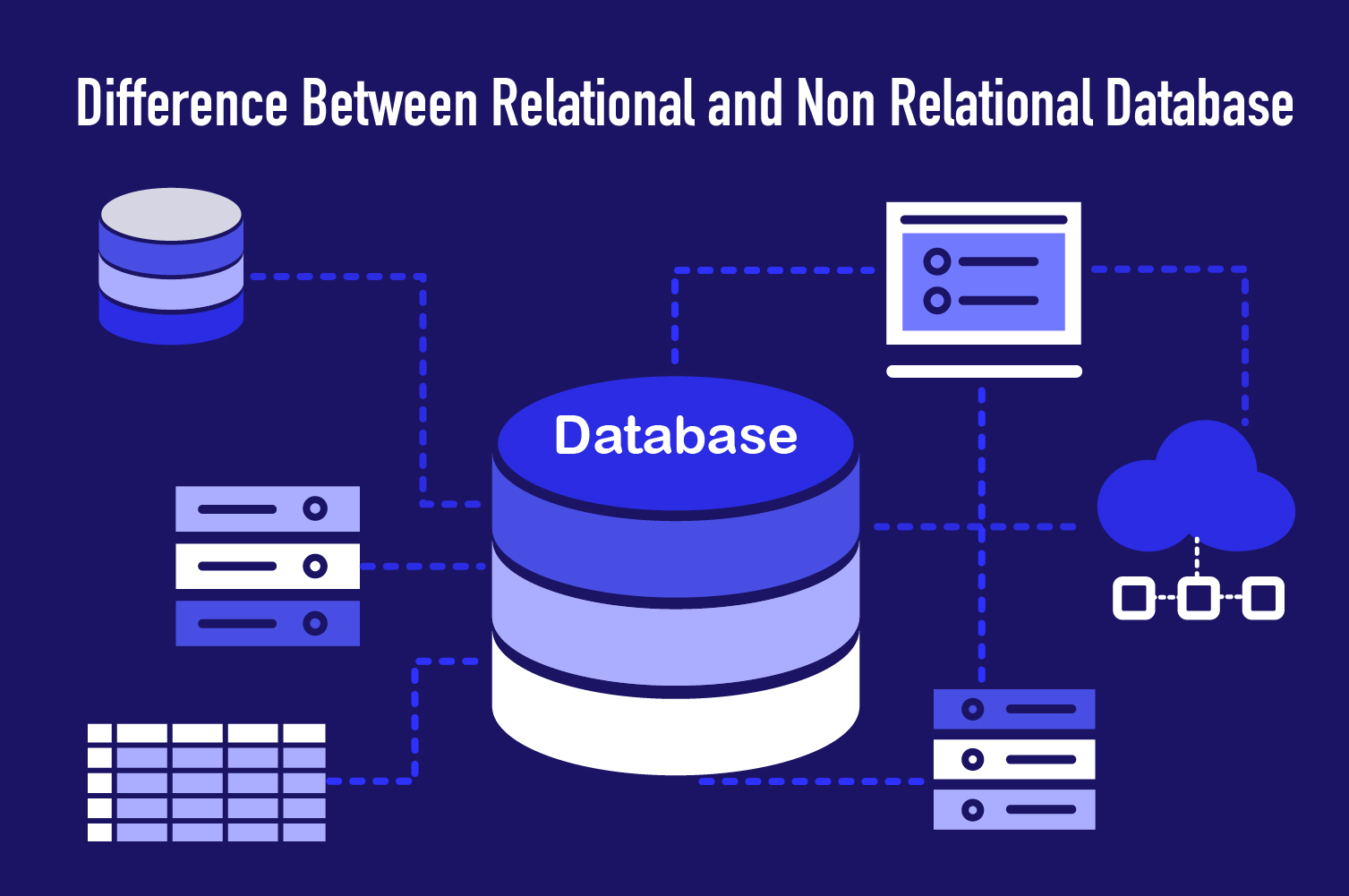
In the ever-evolving landscape of data management, two distinct approaches have emerged: SQL (Structured Query Language) databases and NoSQL (Not Only SQL) databases. Each of these database systems comes with its own set of characteristics, strengths, and ideal use cases. At Lensoft, we understand the importance of making informed decisions when it comes to selecting the right database solution for your business needs.
Differences between Relational databases(SQL) and NoSQL
1. Data Model

Relational databases(SQL) use a structured data model that represents data in tables with rows and columns. These tables are interconnected through relationships defined by keys (e.g., primary keys and foreign keys). Data in relational databases follows a predefined schema, ensuring data integrity and consistency. On the other hand, NoSQL databases employ various data models, including document-based (e.g., JSON or XML), key-value pairs, column-family, and graph databases. They are designed to handle semi-structured or unstructured data and do not require a fixed schema. This flexibility makes NoSQL databases suitable for handling dynamic and rapidly changing data.
Relational Databases (SQL):
Structured Data Model: Relational databases use a structured data model that represents data in tables with rows and columns. Each table has a predefined schema, including column names, data types, and relationships with other tables.
ACID Properties: SQL databases adhere to the ACID (Atomicity, Consistency, Isolation, Durability) properties, ensuring data consistency and reliability. Transactions are atomic, and changes are durable.
Fixed Schema: SQL databases require a fixed schema, meaning that the structure of the data must be defined before data insertion. Altering the schema can be complex and may require downtime.
Data Integrity: SQL databases enforce data integrity through constraints, such as primary keys, foreign keys, and unique constraints. This ensures data consistency and prevents data anomalies.
NoSQL Databases:
Flexible Data Models: NoSQL databases employ various data models, including document-based, key-value, column-family, and graph databases. They are designed to handle semi-structured or unstructured data and do not require a fixed schema.
BASE Properties: NoSQL databases follow the BASE (Basically Available, Soft state, Eventually consistent) model, which prioritizes high availability and partition tolerance over strict data consistency.
Schema-less or Schema-flexible: NoSQL databases are schema-less or schema-flexible, allowing you to insert data without predefined schemas or easily modify the structure of data as needed.
Data Diversity: NoSQL databases can handle diverse data types and structures, making them suitable for applications with dynamic and rapidly changing data requirements.
The data model is a fundamental difference between relational (SQL) databases, which use a structured schema and ACID properties, and NoSQL databases, which offer flexible data models, BASE properties, and schema-less or schema-flexible design. The choice between the two depends on your specific application’s data needs and requirements.
2. Schema

In SQL databases have a fixed schema, which means that the structure of the data (table names, column names, data types, relationships) must be defined before data can be inserted. Altering the schema can be complex and may require downtime. Whereas in NoSQL databases are schema-less or schema-flexible. This means you can insert data without predefined schemas or easily modify the structure of data as needed, making them more adaptable to evolving data requirements. Here is the breakdown in detail:
Relational Databases (SQL):
Fixed Schema: SQL databases require a fixed schema, which means that the structure of the data (table names, column names, data types, relationships) must be defined before data can be inserted.
Schema Validation: Data inserted into a relational database must adhere to the predefined schema. Any data that does not match the schema will be rejected, ensuring data consistency and integrity.
Complex Schema Changes: Modifying the schema of a relational database, such as adding or removing columns or altering data types, can be a complex and potentially time-consuming process. It may also require downtime during schema updates.
NoSQL Databases:
Schema-less or Schema-flexible: NoSQL databases are schema-less or schema-flexible, which means that you can insert data without predefined schemas or easily modify the structure of data as needed.
Dynamic Data: NoSQL databases can handle dynamic and evolving data structures. New fields can be added to documents or rows without affecting existing data.
Data Validation: While NoSQL databases do not enforce strict schema validation, some databases offer schema validation options to ensure data quality and consistency when needed.
Adaptability: The schema flexibility of NoSQL databases makes them well-suited for applications where data structures are not known in advance or may change frequently.
The schema is another significant point of differentiation between relational (SQL) databases and NoSQL databases. SQL databases require a fixed schema, ensuring data consistency and adherence to predefined structures, while NoSQL databases offer schema flexibility and adaptability to accommodate dynamic and evolving data requirements. The choice depends on the level of data structure predictability and flexibility required for your application.
3. Query Language

The SQL databases use structured query language (SQL) for querying and manipulating data. SQL is powerful and standardized, making it suitable for complex queries, aggregations, and reporting. Whereas NoSQL databases use various query languages or APIs, depending on the database type. While some NoSQL databases offer SQL-like query languages, others may have more limited querying capabilities. Let’s explore further the differences:
Relational Databases (SQL):
Structured Query Language (SQL): SQL databases use the Structured Query Language (SQL) for querying and manipulating data. SQL is a powerful and standardized language for defining, querying, and managing relational databases.
Rich Query Capabilities: SQL offers rich query capabilities, including SELECT (for data retrieval), INSERT (for data insertion), UPDATE (for data modification), DELETE (for data deletion), and complex JOIN operations for combining data from multiple tables.
Complex Queries: SQL is well-suited for complex queries, aggregations, and reporting tasks. It allows users to define precisely what data they want to retrieve or manipulate.
NoSQL Databases:
Diverse Query Languages: NoSQL databases use various query languages or APIs, depending on the database type and the data model employed. Some NoSQL databases offer SQL-like query languages, while others may have more limited querying capabilities.
Querying Varies by Type: The query capabilities of NoSQL databases can vary widely depending on the type of database. For example, document-based databases may use JSON-like queries, key-value stores may support basic retrieval operations, and graph databases have specialized query languages for traversing graph structures.
Flexible but Varied: NoSQL databases are flexible in terms of querying but do not provide a single standardized query language like SQL. Users may need to learn different query languages for different NoSQL databases.
Note, the query language is an important distinction between relational (SQL) databases, which use SQL for structured and complex querying, and NoSQL databases, which employ diverse query languages and APIs tailored to their specific data models. The choice of database type may depend on the complexity of your data querying requirements and your familiarity with the query language used by the database.
4. Scalability

Relational databases are traditionally designed for vertical scaling (scaling up by adding more resources to a single server). Horizontal scaling (scaling out by adding more servers) can be challenging and may require complex replication and sharding techniques while NoSQL databases are often designed for horizontal scalability from the outset. They can distribute data across multiple servers or nodes, allowing for seamless and cost-effective scaling as data volume and traffic increase.
Relational Databases (SQL):
Vertical Scaling: SQL databases are traditionally designed for vertical scaling, which means adding more resources (CPU, RAM, storage) to a single server to handle increased workloads. This approach can be effective up to a certain point but may have limitations.
Complex Scaling: Scaling vertically beyond a certain threshold can become complex and expensive. Eventually, you may encounter hardware limitations that cannot be easily overcome.
Read-Heavy Workloads: SQL databases are well-suited for applications with predominantly read-heavy workloads, where high transactional consistency is required.
NoSQL Databases:
Horizontal Scaling: NoSQL databases are designed for horizontal scaling, allowing you to add more servers or nodes to your database cluster to handle increased traffic and data volume. This approach is often more cost-effective and scalable.
Elastic Scalability: NoSQL databases offer elastic scalability, where you can easily add or remove nodes as needed to accommodate changing workloads. This flexibility is valuable for applications with unpredictable or rapidly growing data.
Write-Heavy Workloads: NoSQL databases excel in scenarios with high write loads, such as real-time data ingestion and analytics, where distributed, parallel writes are essential.
Scalability is a significant factor distinguishing relational (SQL) databases, which are typically vertically scaled, from NoSQL databases, which are designed for horizontal scaling and offer greater flexibility and cost-effectiveness when handling dynamic and high-volume workloads. The choice between the two depends on your application’s scalability requirements and growth projections.
5. ACID vs. BASE
.png)
In this part the SQL databases follow the ACID (Atomicity, Consistency, Isolation, Durability) properties, which ensure strong data consistency and reliability. This makes them suitable for applications where data integrity is critical, such as financial systems. On the other hand NoSQL databases follow the BASE (Basically Available, Soft state, Eventually consistent) model, which prioritizes high availability and partition tolerance over strict consistency. This makes them suitable for applications that can tolerate some level of data inconsistency and prioritize performance and scalability. Let me explain further in details below:
Relational Databases (SQL):
ACID Properties: SQL databases adhere to the ACID (Atomicity, Consistency, Isolation, Durability) properties, which ensure strong data consistency and reliability.
- Atomicity: Transactions in SQL databases are atomic, meaning they are treated as a single unit of work. Either all the changes within a transaction are applied, or none of them are.
- Consistency: SQL databases maintain data consistency by enforcing integrity constraints, such as primary keys and foreign keys. Data must meet predefined rules to be inserted or modified.
- Isolation: Transactions in SQL databases are isolated from each other to prevent interference. Isolation ensures that one transaction does not see the intermediate changes made by another until it is complete.
- Durability: Changes made within a transaction are durable and will persist even in the event of system failures.
NoSQL Databases:
BASE Properties: NoSQL databases follow the BASE (Basically Available, Soft state, Eventually consistent) model, which prioritizes high availability, partition tolerance, and eventual consistency over strict data consistency.
- Basically Available: NoSQL databases aim to be continuously available for read and write operations, even in the presence of failures. This may involve trading off strict consistency for availability.
- Soft State: Soft state implies that the state of the system can change over time due to factors like data replication and network partitioning. Soft state allows for flexibility and adaptability.
- Eventually Consistent: Instead of strict consistency, NoSQL databases provide eventual consistency. This means that given enough time and once the system stabilizes, all replicas of the data will converge to the same state.
In summary, the ACID vs. BASE comparison highlights the different data consistency and reliability models between relational (SQL) databases and NoSQL databases. SQL databases prioritize strong consistency and reliability through ACID properties, while NoSQL databases prioritize high availability, adaptability, and eventual consistency through BASE properties. The choice between the two depends on the specific requirements of your application, with SQL databases favored for scenarios where data integrity is critical and NoSQL databases for scenarios where flexibility and scalability are paramount.
6. Use Cases

When we look at the differences, the SQL databases are well-suited for applications with structured data and complex relationships, such as financial systems, e-commerce platforms, and traditional enterprise applications while NoSQL databases are suitable for applications with varying data structures, high write loads, and the need for rapid scalability, such as social media platforms, real-time analytics, IoT, and content management systems. Below is a more detailed explanation on the differences between the two:
Relational Databases (SQL):
Structured Data: SQL databases are well-suited for applications that deal with structured data, where data conforms to a fixed schema with well-defined relationships between tables.
Complex Queries: They are ideal for applications that require complex querying, reporting, and data analysis, such as financial systems, CRM (Customer Relationship Management) software, and traditional enterprise applications.
Transactions: SQL databases are commonly used in scenarios where data integrity, transactional consistency, and adherence to ACID properties are critical, such as e-commerce platforms and banking systems.
Mature and Proven: SQL databases have a long history and are well-established in industries where data accuracy and reliability are paramount.
NoSQL Databases:
Unstructured or Semi-Structured Data: NoSQL databases are suitable for applications dealing with unstructured or semi-structured data, such as JSON or XML documents. They can accommodate diverse data types and evolving data structures.
Scalability: They excel in scenarios with high write loads, massive data volumes, and the need for horizontal scalability. Examples include social media platforms, real-time analytics systems, and IoT (Internet of Things) data processing.
Flexible Schemas: NoSQL databases are advantageous when data structures are not well-defined in advance or when the schema evolves frequently. Content management systems, cataloging systems, and recommendation engines benefit from schema flexibility.
High Availability: NoSQL databases are used in applications where continuous availability is critical, even in the face of hardware failures or network partitioning. This includes content delivery networks and online gaming platforms.
The choice between relational (SQL) databases and NoSQL databases depends on the specific use case and data requirements of your application. SQL databases are suited for structured data and scenarios where data integrity and complex querying are essential, while NoSQL databases are favored for handling unstructured data, scalability, flexibility, and high availability in dynamic and rapidly changing environments. Often, a combination of both database types is used in complex applications, leveraging the strengths of each as needed.
In conclusion, the distinctions between SQL and NoSQL databases are pivotal in shaping database management strategies. SQL databases, characterized by structured schemas and ACID properties, excel in applications that prioritize data integrity, complex queries, and transactional consistency. Conversely, NoSQL databases, embracing schema flexibility and BASE properties, find their strength in managing unstructured data, providing scalability, and ensuring high availability. Choosing the right database type hinges on the specific needs of the application, with SQL databases offering reliability, and NoSQL databases delivering adaptability and performance in evolving data landscapes. In many cases, a strategic blend of both database types emerges as the optimal solution to meet the diverse demands of modern data-driven applications.